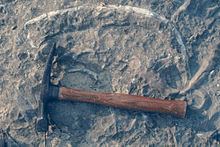Type sedimentary Named for Jeffersonville | Underlies Sellersburg Limestone Country United States Primary Limestone | |
 | ||
Sub-units Dutch Creek Sandstone Member, Geneva Dolomite Member, Vernon Fork Member Thickness 20 ft at Louisville, KY, 0 to 61 m in southwest Indiana | ||
The Devonian Jeffersonville Limestone is a mapped bedrock unit in Indiana and Kentucky. It is highly fossiliferous.
Contents
Description
The Jeffersonville is a coarse grained, dark gray, thick bedded, fossiliferous limestone.
R. D. Perkins (1963) divided the Jeffersonville into five zones based on petrology and fossil content, and these are summarized below (in stratigraphic order):
Fossils
The Jeffersonville Limestone is well known for its fossils, including the well-exposed corals, many in life positions, at Falls of the Ohio.
Edward Kindle described many species from the Falls of the Ohio in 1899:
Campbell and Wickwire (1955) listed the following species in the Jeffersonville from outcrops in the vicinity of Hanover, Indiana:
Other trilobites include the following: Arctinurus sp., Anchiopsis anchiops, Anchiopsis tuberculatus, "Calymene" platys, Coronura aspectans, C. myrmecophorus, C. helena, Crassiproteus clareus, C. crassimarginatus, C. macrocephalus, Greenops kindlei, Odontocephalus bifidus, O. magnus, Odontochile pleuroptyx, Phacops nasutus, Phacops pipa, Trypaulites calypso
Ostracods were documented by Kesling and Peterson in 1958. Genera identified include: Abditoloculina, Adelphobolbina, Ctenoloculina, Flaccivelum, Hollina, Hollinella, and Subligaculum.
The Blastoids Codaster alternatus and Codaster pyramidatus, among others, were identified by Cline and Heuer in 1950 at Falls of the Ohio.
Notable exposures
Type locality is at Falls of the Ohio State Park near Louisville, Kentucky.
Age
Relative age dating places the Jeffersonville in the lower to middle Devonian. Devera and Fraunfelter identified it as Emsian-Eifelian based on coral and foraminifera.
